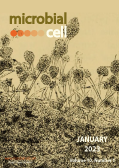Table of contents
Volume 10, Issue 1, pp. 1 - 17, January 2023
Cover: Graphic depiction of Aspergillus Fumigatus as illustrated in "A treatise on the diseases of the ear including the anatomy and physiology of the organ together with the treatment of the affections of the nose and pharynx which conduce to aural disease" (1894, page 219, Fig. 64) by Mark Hovell and published by J. & A. Churchill (London, UK). The figure legend reads "Aspergillus Fumigatus: Hyphae and Organs of Fructification. Culture in Gelatine. x 60. (Siebenmann). The image was digitalized by Open Knowledge Commons and Yale University, Cushing/Whitney Medical Library; image modified by MIC). The cover is published under the Creative Commons Attribution (CC BY) license.
Enlarge issue cover
Cellular cholesterol licenses Legionella pneumophila intracellular replication in macrophages
Edna Ondari, Ashley Wilkins, Brian Latimer, Ana-Maria Dragoi and Stanimir S. Ivanov
Research Articles |
page 1-17 | 10.15698/mic2023.01.789 | Full text | PDF |
Abstract
Host membranes are inherently critical for niche homeostasis of vacuolar pathogens. Thus, intracellular bacteria frequently encode the capacity to regulate host lipogenesis as well as to modulate the lipid composition of host membranes. One membrane component that is often subverted by vacuolar bacteria is cholesterol – an abundant lipid that mammalian cells produce de novo at the endoplasmic reticulum (ER) or acquire exogenously from serum-derived lipoprotein carriers. Legionella pneumophila is an accidental human bacterial pathogen that infects and replicates within alveolar macrophages causing a severe atypical pneumonia known as Legionnaires’ disease. From within a unique ER-derived vacuole L. pneumophila promotes host lipogenesis and experimental evidence indicates that cholesterol production might be one facet of this response. Here we investigated the link between cellular cholesterol and L. pneumophila intracellular replication and discovered that disruption of cholesterol biosynthesis or cholesterol trafficking lowered bacterial replication in infected cells. These growth defects were rescued by addition of exogenous cholesterol. Conversely, bacterial growth within cholesterol-leaden macrophages was enhanced. Importantly, the growth benefit of cholesterol was observed strictly in cellular infections and L. pneumophila growth kinetics in axenic cultures did not change in the presence of cholesterol. Microscopy analyses indicate that cholesterol regulates a step in L. pneumophila intracellular lifecycle that occurs after bacteria begin to replicate within an established intracellular niche. Collectively, we provide experimental evidence that cellular cholesterol promotes L. pneumophila replication within a membrane bound organelle in infected macrophages.










